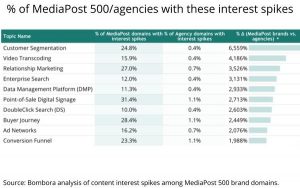We all know that video is an incredibly popular format, but did you know that simply using the word ‘video’ in an email subject line boosts open rates by up to 13%, and embedding a video into an email can result in a conversion rate that’s 21% higher than emails containing only static images, according to research by Experian. In fact, video is so well loved that Cisco predicts 80% of all global consumer internet traffic will be video-based by 2019.
If anyone doubts the power of video look no further than the excellent 2016 Content Marketing Association (CMA) Video Engagement report.
The CMA surveyed brands, media owners and creative agencies to create a report that’s packed with great stats. Here are just some:
- 92% said video content was either important or very important to their content marketing strategy
- 55% said that mobile, rather than desktop or tablet, is the primary channel for video content
- 95% said the optimum length of a branded video is under three minutes
- 55% said that brand storytelling was the main purpose of video in content marketing
Be certain video is the right medium
Snackable content
We’re all aware from our own experience that video is engaging and can make even the most complex message easy to digest. This is a critical factor if you’re looking to break through a cluttered content landscape. Heidi Cohen writes in her Actionable Marketing Guide that easy and quick to consume information allows your audience to get your message without risking it being putting aside. We need to make this content ‘snackable’ and she stresses the importance of using short visual content to feed on-the-go consumption.
Our clients’ love affair with video is also on the rise and we continue to work on lots of great projects where video is either a lead component or an integral part of the campaign. Indeed, a day rarely goes by without us having a conversation with a client or potential client about video content. Many are keen to invest big budgets in a ‘video campaign’ but, as Andy Greenhouse (Co-Founder of Swhype Media) said: “Whether or not video is an essential part of a company’s marketing activity is dependent on what needs to be communicated, through which platforms, and to which specific target audience.”
I recall a few years ago a conversation with a great client who felt they “ought to have an app’’ for a critical internal communications piece, but, in fact, as we explored the target audience with them it was clear that the last thing they needed was an app. In this instance, it simply wasn’t the right tool for the job or the right way to reach their staff. We’re having some similar conversations around video with clients eager “to have a video campaign” whilst at times being unsure why or what they want to achieve with it.
Build in the time on any video project plan to clarify the target audience
Obstacles to success
Ascend2 carried out research in 2015 and cited lack of an effective strategy as the most challenging obstacle to video marketing success, according to nearly 48% of companies surveyed. They stated that a strategy with sufficient resources and budget to produce compelling content is critical to success.
We couldn’t agree more, particularly the importance of compelling content, and that’s why we always urge our clients to build in the time on any video project plan to clarify the target audience in detail and distil the message they want to deliver. We all know that understanding your audience is the first step to communicating with them effectively, but when it comes to video the basics sometimes go out the window and people mistakenly think that simply creating something visual will guarantee viewers.
We’ve found it really effective in internal communications for companies that need to deliver difficult or complex change messages
Not so. Here are some of our learnings from the work we’ve been doing:
- Think carefully about who you want to speak to with your video. Who are they, what are the best channels to reach them on? Be certain video is the right medium for them. It might well be, but it never hurts to ask the obvious questions.
- Think about what you want to say and then distil your message to its core points. I’ve already mentioned the CMA’s findings that the optimum length is under three minutes. We’ve had our biggest successes with clients who really cut their message to its very essence and helped us to deliver videos of 1.5 to two minutes maximum. One of the biggest challenges we face is when one of the main benefits of video – its ability to make a complex message simple – isn’t utilised. Don’t try and say everything and end up with a 10 minute short film. You’ll lose your audience.
- Work with your agency on a clear strategy. The first two points are clearly part of that but think about whether this is the start of a regular online video presence; does it lead on from previous campaigns or is it a one-off? Will your initial target audience expand and who will you be talking to six months or a year from now?
- Think now about whether your video is part of a series and plan the series well in advance. It’s worth committing some of your budget to a series of storyboards in advance so you know that ‘video one’ is spot on as the opening to your series.
- Think carefully about your budget and be realistic about what can be achieved. Great things can be done with small budgets, but setting a clear budget from the very start will help you and your agency come up with ideas and solutions you can afford.
- Words, people, music, animation? I always start by asking clients what they have recalled or responded to in the last year. It’s a great way to begin gathering thoughts on the approach you want to take. We’ve often ended up creating cost effective animations for clients who thought they wanted a serious video with ‘real’ people. Don’t overlook the power of animation in the video mix. It can be a great way to deliver serious messages. We’ve found it really effective in internal communications for companies that need to deliver difficult or complex change messages.
- What reaction do you want from your audience once they have seen your video? Think carefully about it and think about ways of measuring that reaction to see what percentage of your audience respond in the way you intended.
- Does your video add value to the viewer and if so how? Is it helping them do their job better? Is it educational? Is it inspirational? Does it make them laugh?
- Think about your KPIs. We work with clients to tease out what they think the key performance indicators should be, because clearly your video needs to achieve much more than just number of views.
If you haven’t already experimented with video as a way of telling your story, whatever that story is, clearly now is the time. But don’t rush in. Think carefully about what you want to achieve, find an agency you trust to help you come up with the best possible ideas for your audience. Video is a versatile medium and offers so many ways to engage your audience. With planning, a clear strategy and even clearer message there should be few barriers to success.
Digital & Social Articles on Business 2 Community
(47)





